Alfa Romeo Giulia vs. BMW M3 vs. Mercedes-AMG C63: The Road & Track Test
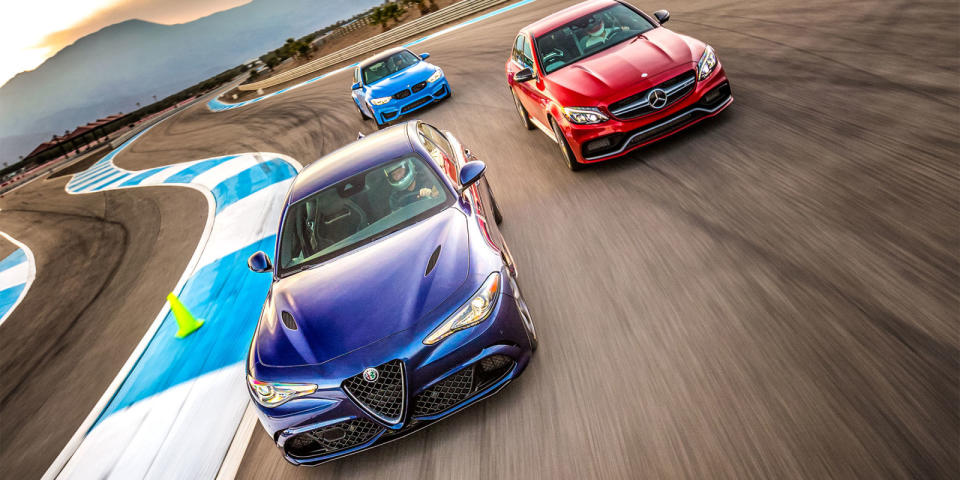
STAND AN OMEGA SPEEDSTER PROFESSIONAL on its face, and you'll find an inscription on the case back: "Flight-qualified by NASA for all manned space missions. The first watch worn on the moon." For a certain kind of person, that inscription is irresistible. It's a piece of something bigger, the ordinary made exceptional. The appliance that can go into orbit.
That person wants a European sedan. Eighty large in pocket, the well-to-do modern enthusiast is jonesing for an over-powered commuter with paddle shifters and pedigree. He or she is spoiled for choice. BMW, Mercedes, and Alfa Romeo all made hay on the back of touring-car racing. Each earned a cult following decades ago by way of competition-minded engineering and sharp homologation road cars. Machines like the E30 M3, Mercedes 190E, and Alfa 155 defined the breed. BMW and Mercedes offer successors to those icons in the four-door M3 and C63. Now, after more than two decades absent from the U.S. sedan market, Alfa Romeo has returned with the all-new Giulia Quadrifoglio, reuniting a holy trinity of sorts.
We wanted to know if the Alfa is a legit contender, and how the descendants of those track-qualified touring-car icons stack up on the racetrack. So we went to the Thermal Club, a private road course complex outside Palm Springs. We gathered the new BMW M3, the Mercedes-AMG C63 S, and the Alfa Romeo Giulia Quadrifoglio. And we sent them into orbit.
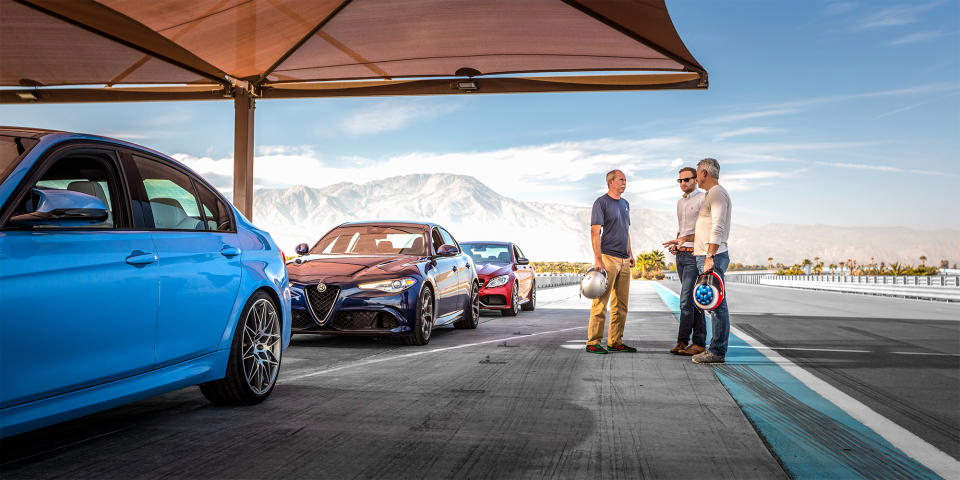

OUR PARTY REPORTS AT 8:00 A.M. to walk the circuit. Contributing editor Preston Lerner, soft-spoken club-racing veteran, is here. So is the boss, editor-in-chief Kim Wolfkill. We'll start the day at the North Palm course, a 1.2-mile Armco fortress opening with a fast carousel and ending with a tricky hairpin. The surroundings reek of resort, all ozone-scraping palm trees and half-built luxury condos. The track is new but already scuffed, like secondhand high-tops. Most of the tire marks disappear into run-off; many end abruptly at the barriers. This is where we'll take turns caning the Alfa, an initiation. "Welcome back. Glad you're here. Go climb that curbing."
We'd usually be gunning for the BMW. Now in its fifth generation, the M3 represents the traditional track-focused choice in this segment. Our 3662-pound tester has a seven-speed dual-clutch automatic and the new Competition package, which adds 19 hp. The least powerful engine here, the BMW's twin-turbocharged 3.0-liter inline-six pumps out 444 hp and 406 lb-ft of torque. The Mercedes-AMG C63 S is more hot rod, a leather-stuffed living room with a V8. Curb weight is 3958 pounds, and AMG's twin-turbo 4.0-liter is rated at 503 hp and 516 lb-ft. That runs through a seven-speed automatic, which has a fluid-bathed clutch pack in lieu of a torque converter.
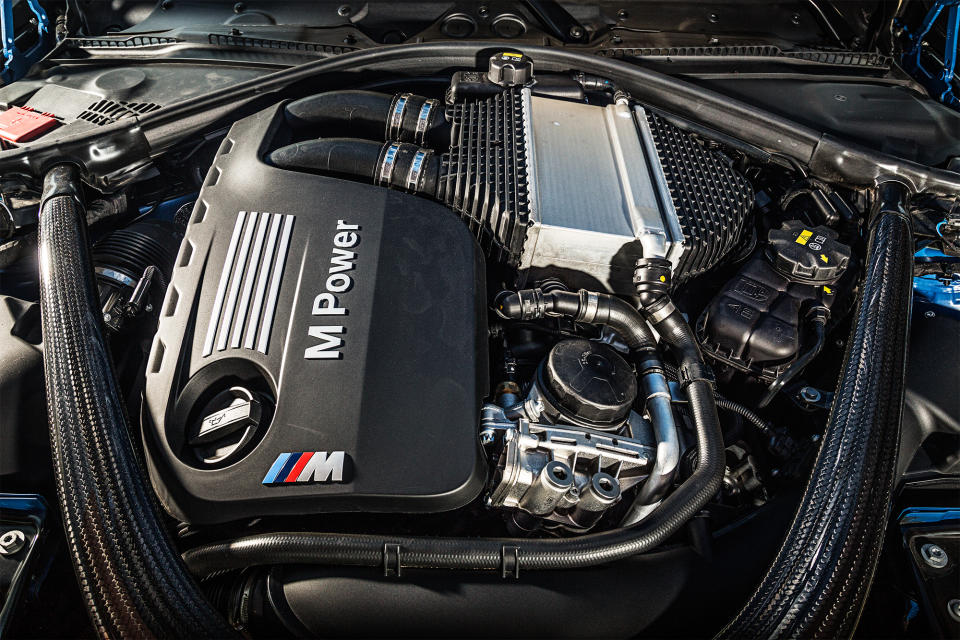
But Alfa has our attention. The storied brand, once purveyor of high-energy, tail-happy featherweights, hasn't done a rear-drive sedan since Dire Straits was touring. We know this new car weighs 3822 pounds and reaches a claimed 191 mph. We know it packs 505 hp and 443 lb-ft of torque from a twin-turbo 2.9-liter V-6 mated to a conventional eight-speed automatic. But we don't know much else.
The first lap is a shocker. The steering isn't huge on feedback but feels airy through the Giulia's thin wheel, delicate like a Ferrari's. Skim milk to the usual German cream. It's straight-razor-sharp, too, a sensation amplified by the quick 11.8:1 ratio. Wolfkill makes the day's first proclamation. "Without knowing the track, I feel more comfortable going quickly in this car than an M3. On first impression, the Alfa seems flatter. It's got more grip, better turn-in."

The brakes are great, too. The Giulia we're driving has carbon-ceramic rotors, 15.4 inches front and 14.2 inches rear, a $5500 option. The standard kit is plenty. We tested the iron-rotor setup later, and it pulled the shortest stops of the group.
The Quadrifoglio is stable scrubbing speed and generally light on its feet. Plus, it's got the stoutest engine: A small, twin-turbo V6 doesn't read as exciting, but this one is effectively a Ferrari California T's V8 minus two jugs-same bore and stroke, same 90-degree angle. Boost is set at a manic 35 psi. So, the Quadrifoglio moves like an arms-grade pressure cooker: lame down low, then incendiary between 3500 and 6500 rpm. It's a belligerent spool-and-shove routine with induction whirl and exhaust whap to match. Next to that, the M3 might as well be parked on the front straight.
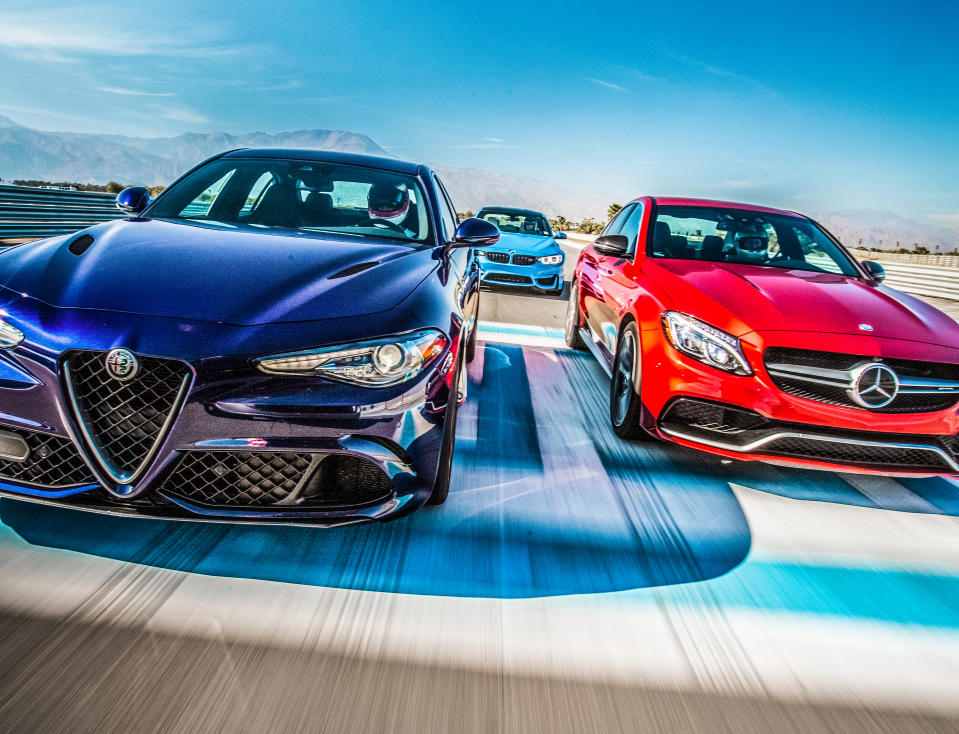
Only the Mercedes can keep up. That's a relief, because emissions and fuel-economy considerations have killed off AMG's short-stroke pièce de résistance, the M156-code 6.2-liter V8 that powered the firm's "63" cars until recent years. That naturally aspirated dinosaur invited stock-car reverie and defined the C63's glorious big-bore character. The new 4.0-liter delivers most of the same feel and all the same ruckus. It's an unstoppable device that recalls rolling thunder and white lightning, well worth the price of entry. There's apish grunt, zero perceptible lag, and a tach needle that whips around the dial far more freely than you'd think. The torque curve is madness from just off idle to 4500 rpm. The C63 has always been an engine-first car. Forced induction hasn't spoiled it. This might be the most exciting boosted eight on sale today.
It also might be an anchor. The Merc feels thick-necked, the only car here that needs to be bullied. Imagine all the sensations of an Aussie V8 Supercar with the operational finesse of a steamroller. I'm struggling through the track's carousel, pushing wide where the Alfa came through nonplussed and going faster. Lerner returns from his stint complaining of understeer, too. The beast, the heaviest in our bunch, is leaning on those 245-section front tires, which got hot and needed a break between sessions.
Predictably, the M3 fares better. It's quick through the carousel and carries as much speed as the Alfa exiting the hairpin. The BMW is packing serious hardware, as ever: carbon roof and driveshaft, rigid-mounted rear subframe, trick limited-slip diff. The Competition package brings different springs, larger anti-roll bars, and retuned dampers. Enough to win over Lerner, who's high on the steering and balance. Wolfkill gives props for chassis stiffness and front-axle grip, noting the M3 has the most tire, 265/30 fronts and 285/30 rears. He seems enamored of the Alfa, though, saying it's nimbler and less of a handful.
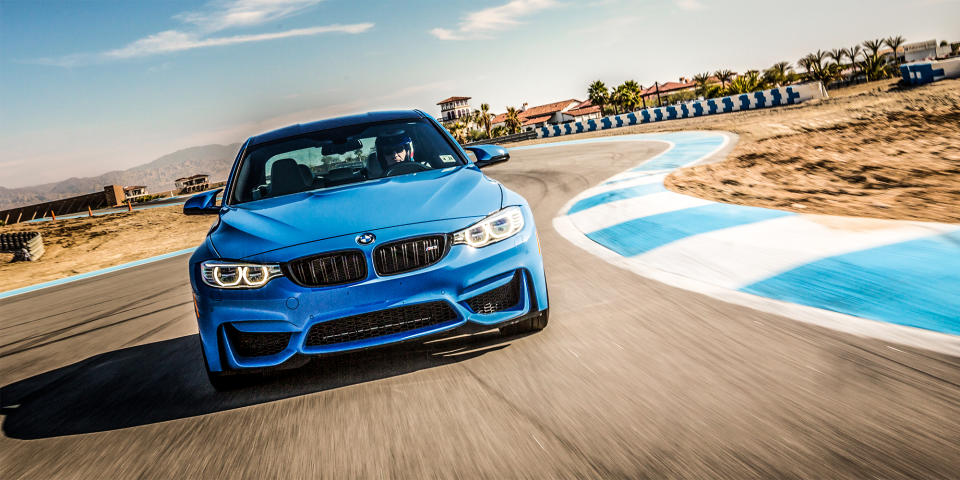
Instead of fighting understeer, like the Mercedes, the BMW has problems at the other end. In lower-speed corners, the rear feels light, searching for grip under hard acceleration. Add an overeager electronics suite, and intervention is nearly constant. On the short track, the M3 comes off skittish and distant. So while Lerner and Wolfkill go for lunch, I sneak away and get a head start on our afternoon session at Thermal's faster, flowing, 1.8-mile South Palm circuit.
Three years into production, it's safe to say the F80-chassis M3 hasn't exactly rung purists' bells. As someone raised on a steady diet of junky old BMWs, I can see why. Compared with those cars, gold standards for steering feel, the new electric-assist M3 is inert. It's too big, too traction-compromised. But there's still greatness here. You just have to hustle to find it.
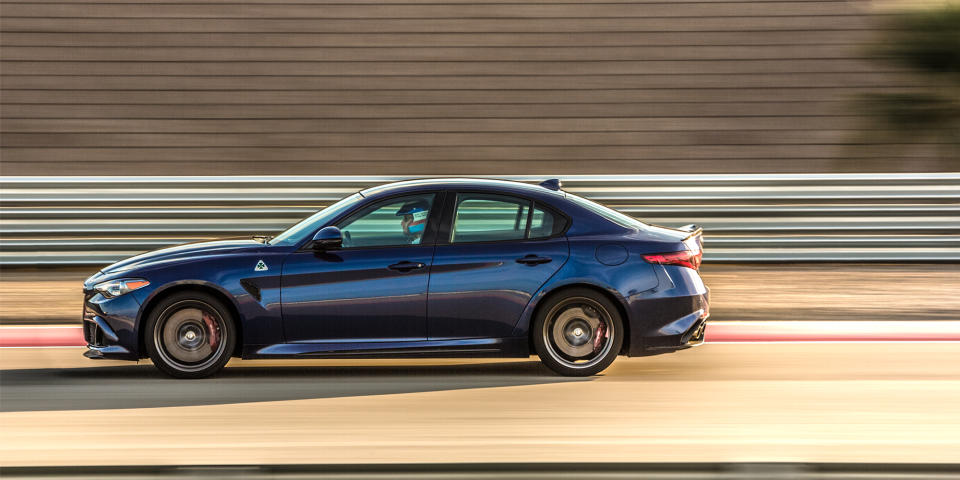
Electronics switched off, the M3 starts to give back. Grip improves with speed and load, as does balance and overall response. It demands smooth inputs and rewards them, lets you blend in corrections, carrying momentum. The M3's gearbox, sightlines, and seating position are all tops in this group. That cuts through the clutter, so you start playing with how you approach the car's controls. It makes you want to improvise, assemble lap after lap, hemming and prodding and exploring. Also maybe throw a set of R-compound tires in the trunk and drive across the country trolling 911s at track days. The M3 has always been good for that.
It's starting to attract Wolfkill. He fell fast for the Alfa, but now he's cooling on it even faster. Both Germans wear Michelin Pilot Super Sports; the Italian rolls sticky Pirelli P Zero Corsa track tires, and they're beat after our morning session. Lerner, cautiously optimistic, takes some laps and returns lukewarm.
"As the tires wear, turn-in is unusually abrupt. The car always seems to be driving off the outside rear wheel, too. It just feels disjointed." He's also bumming on the Alfa's flappy paddles. "Column-mounted levers," he sighs.
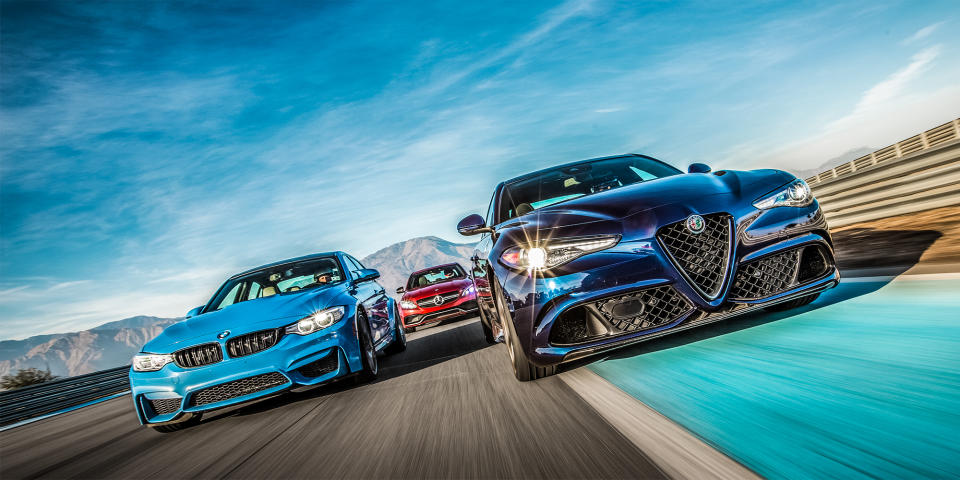
Ninety-eight percent of the time, it's no problem. That last two percent inevitably rears its head midcorner, when your hands are in the exact wrong position to grab a shift. Then the Alfa stubs its toe on the rev limiter, giving the transmission pause. This is a slushbox impersonating a dual-clutch. It breaks character when pressed.
The Mercedes pulls a Keyser Söze. Upshifts sound like cannon fire and land instantly. Downshifts come almost as fast, with a colossal, satisfying whoomf! from under the hood. On a flier down the one-third-mile back straight, crossing a buck-thirty, the C63 reels in the Quadrifoglio and absolutely freight-trains the M3.
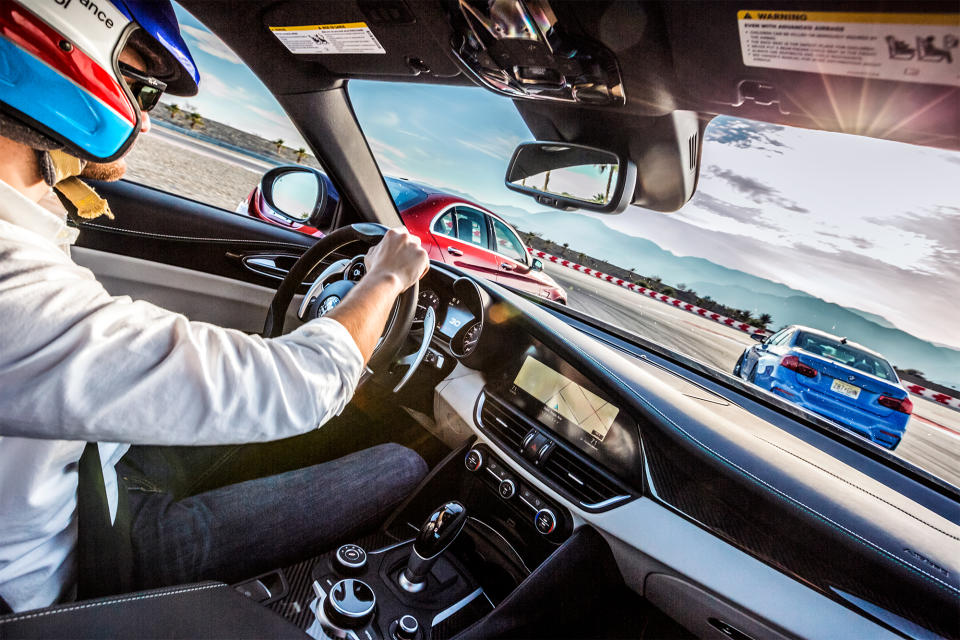
Serious speed, demanding serious brakes. Like the Alfa, both our BMW and Mercedes test cars wear carbon-ceramic brakes. On the former, it's an extravagant $8150 option; the latter, a more reasonable $5450. But there's a catch: The M3 brings carbon rotors all around, while the C63 S only gets them up front. The Merc's setup can exhibit signs of fade if you use it to haul down from triple digits repeatedly. It takes a few minutes of cooldown in the paddock for them to return. Wolfkill climbs out smiling.
"Works much better on the bigger track," he says, seeming relieved.
Stability control off, lumbering through South Palm's squiggly back complex, the AMG is an evergreen source for low-hanging oversteer. It makes for wild eyes and impure thoughts, all while seated upright, clavicle-deep in soft leather. The dissonance is a hoot.
While both Germans gain favor on the bigger track, the Italian's novelty factor wears thin. It's suspect of drama-by-design, same as Alfa's mid-engine 4C. That car is a bit smoke and mirrors, akin to what someone who's never driven a race car would think a race car feels like. The Quadrifoglio is similarly edgy, to the point of feeling disconnected. Finding a rhythm takes serious work.
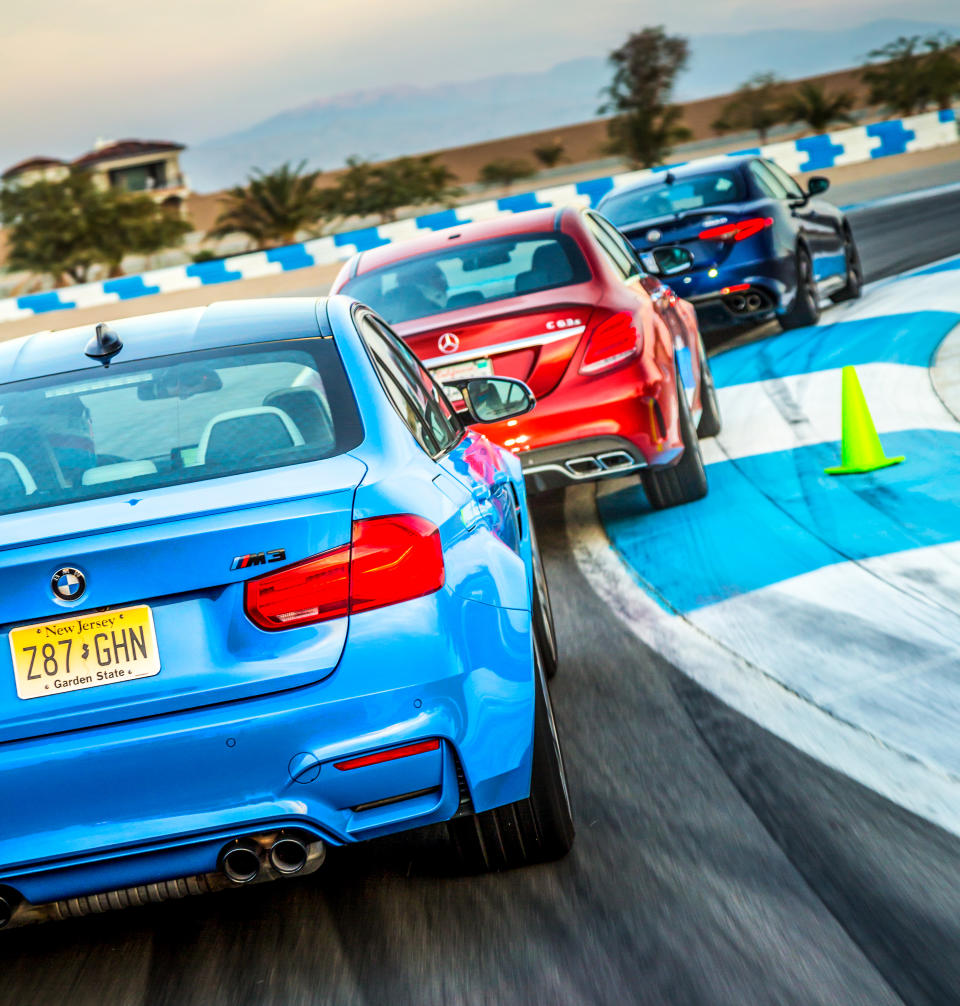
"The steering wheel is a master class in wannabe design," gripes Lerner. "Flat bottom, red push-start button, Alcantara, and carbon-fiber inserts? All right, already. We get it."
Wolfkill's not so sure that represents a problem.
"It feels like a tuner car, but the tuner is Ferrari. There are worse things. The chassis balance and mechanical grip might be the best out here. Definitely better than the Mercedes, posssibly superior to the BMW."
To which Lerner raises an excellent point: "What should track-day sedans be if, realistically, owners don't take them to the track?"


HE'S RIGHT. We went to the racetrack in the interest of due diligence, but we're not living in an era of touring-car racing. If a market for track-toy sedans ever existed, it doesn't any more. Certainly not at $80,000. In that heady territory, a four-door can't be so compromised.
So the next morning, we grab an atlas. We'll make for Palm Desert and blitz Route 74, climbing into the San Jacinto Mountains, where the road gets lonely. Refuel, then head north, hustling after Idyllwild on Route 243 toward Banning.
The Alfa sounds righteous with a head of steam leading the pack to the Coachella Valley Vista Point. Once we're dicing, though, it's clear BMW's six is the one to have. It's far smoother, with a higher redline and a torque curve to match the Merc. It's also attached to a legit dual-clutch, cracking off impeccable shifts through the crisp California morning. On fresh, winding asphalt, the M3 shines.
Less so on rough blacktop. Those adjustable dampers are dried stucco, regardless of setting. The Competition package's 20-inch forged wheels look toothsome, but they aren't doing the ride any favors on a 30-series tire. Friskier buyers might not mind, and, as Wolfkill points out, they're the most likely to reap benefits at the occasional weekend lapping session. But the BMW offers the least forgiving suspension here, and by a large margin.
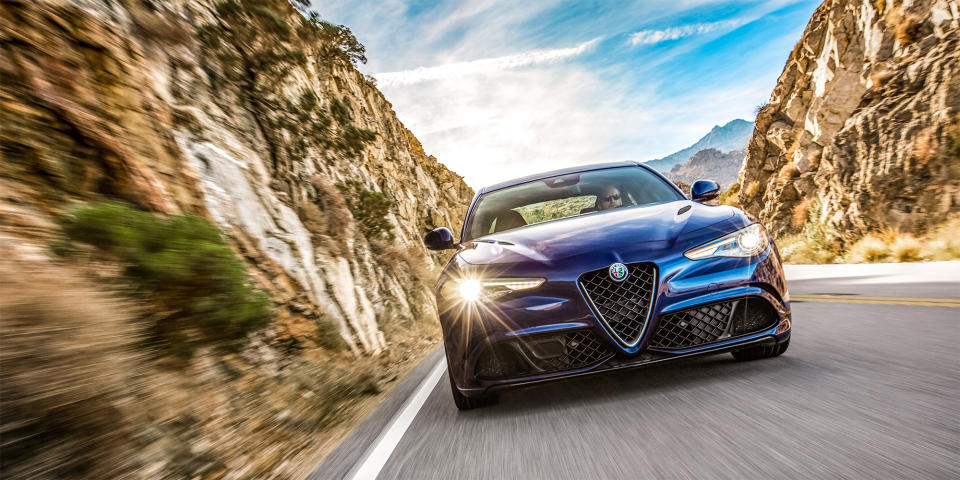
By contrast, there's some kind of sorcery in the Alfa's setup. It's got a unique bumpy-road setting, a specialized damper suite with technology cribbed from Ferrari. The result is absurd compliance, even in the rowdiest drive mode. Potholes, expansion joints, wavy pavement-the car just shrugs it off. An unexpected nuance.
Still, there are issues. Challenging at the track, the Alfa is a chore to hustle smoothly on back roads. Traffic only makes things worse. It exacerbates the hair-trigger throttle tip-in, and the touchy brake pedal is giving me fits. So are the manual seat adjustments. While the optional carbon-fiber Sparco buckets are eye candy, Lerner says he can't nail the right position. I can't either, and Wolfkill notices the driver's side developing "the world's most annoying metal-to-carbon squeak."
Hiccups are to be expected. After all, Alfa Romeo's skunk-works designed this car, clean-sheet, in an impossibly short two and a half years. The effort is commendable, and some people want an at-the-limits veneer at all times. For them, the Quadrifoglio's calibration will be endearing, quirks to keep you on your toes. Those folks might not mind the workaday Fiat-Chrysler cockpit either. We did. Consider it a compelling start, not a mic drop. Wolfkill: "I'd wait for version 2.0."
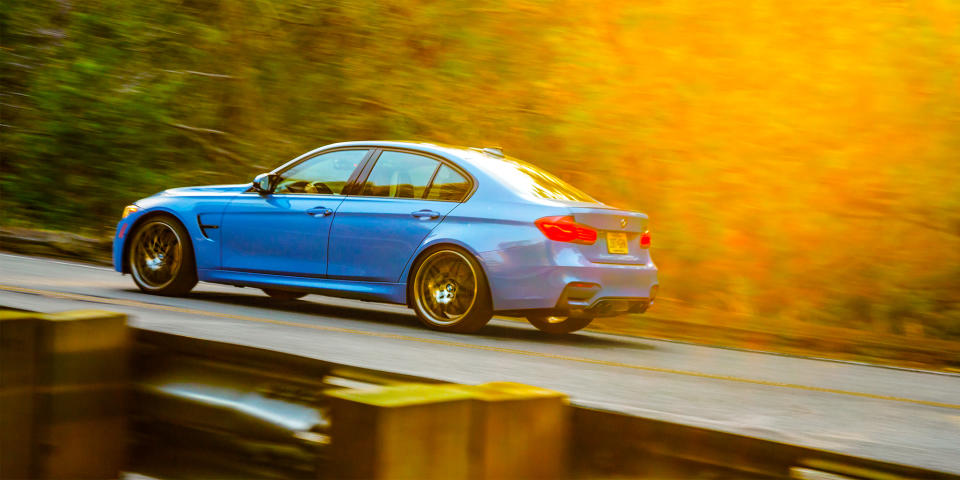
South of Idyllwild, I'm coming around to the BMW. It doesn't communicate like previous generations, but what modern sedan does? If the M3 is the new M5, then this is one hell of an M5. The other guys are already believers. "Still the benchmark," says Wolfkill, "delivering the nameplate's promise, livability with the finest track manners of the bunch."
Lerner's notes read like a preacher thumping the Bavarian bible: "Hands-down the winner driving fast. Engine sounds great, seats are fantastic. It made me the most confident, especially as stability controls were progressively disabled. Modern cars make drivers believe they're heroes; the M3 rewards skill on top of it. An immensely satisfying experience."
I'm not sure about the "sounds great" part (many angry tuba noises, played through the stereo), but he's spot-on otherwise. Chassis balance is right there with the Alfa, yet the BMW is leagues more refined at speed. Less histrionics, more get-down-to-business, from the suspension to the styling and the cabin. (The latter is functional, if maybe not special.) We all agree: Rumors of the M3's demise have been greatly exaggerated.
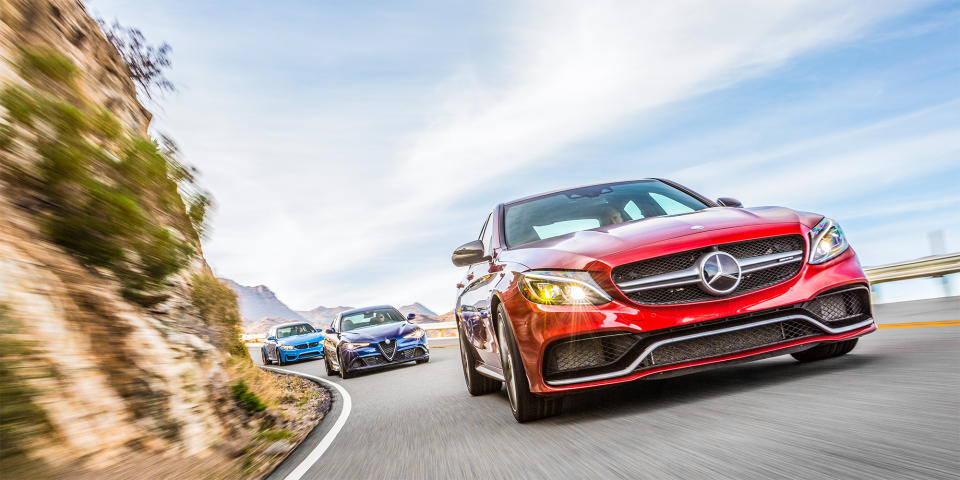
But the C63 S is in a different class, and not just because of its $94,770 sticker. Our test car came swimming in pap, from a fragrance ionizer to mood lighting and semiautonomous cruise control. Even the stripped-down, $73,725, base-model C63 S would blow the Alfa and BMW away. Its cabin is exquisite, substantial, tactile. The car is totally content clicking off miles half-asleep. Then you drop the windows, switch the exhaust to loud mode, and boogie.
The Merc can hang. Through the twisties nearing the end of our run to Banning, it handles a lighter, pointier car's work anywhere below eight-tenths, in the real-world range of operation. Deduct points for grace, then immediately add them back, because that engine just won't quit. Seventeen-some-odd pounds of boost, and the C63 could almost pass for naturally aspirated. It'll make you fall in love with AMG V8s all over again.
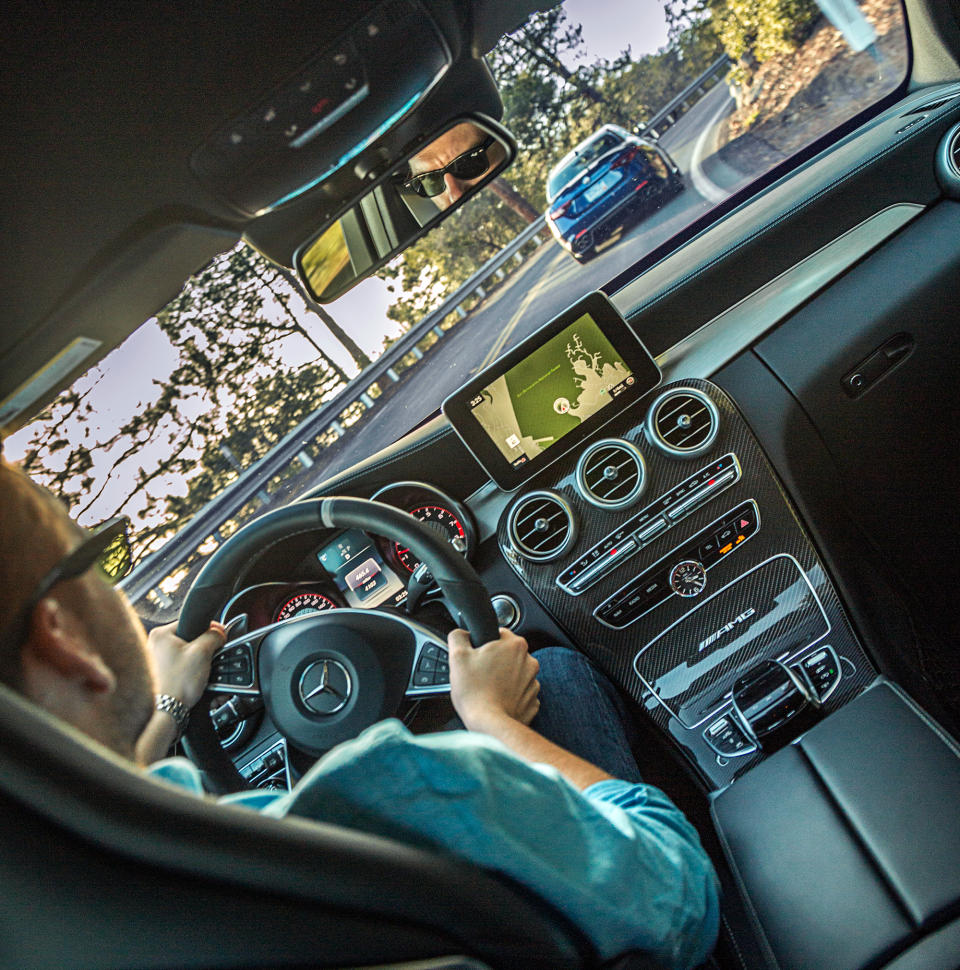
Once we pull off the road and start cracking into this group categorically, nobody can find where the Mercedes is lacking. The steering, meaty and trusty, is just right for the big sedan's personality. The gearbox, buttery around town and snappy under duress, is nearly as brisk as the M3's dual-clutch. The ride, remarkably forgiving, is even better than that of the Alfa.
The lone sticking point is the car's mission. It's a tightrope walk between luxurious fast sedan and luxury sedan that happens to be fast. The demographic that insists on wearing Nomex to buy cat food might find fault there. But ultimately, the AMG is better at being a road car than the other two are at being track cars. Even Lerner, champion of the M3, makes a confession in his notes.
"I'm somewhat chagrined to acknowledge the C63 S is the one I'd spend my own money to own."

Wolfkill echoes that. "Versatility dings it slightly in the performance extreme. But the Mercedes is the one to keep, confident in the knowledge you're not compromising anything of significance for regular use."
Regular use. Those original homologation machines were used regularly in competition. But generations removed, these are consumer goods, not moonshots. Cars don't exist in a vacuum.
To that end, the Giulia Quadrifoglio is the gutsiest, a serious first stab that leaves an impression. The M3 is objectively sharpest, still a siren yet no longer infallible. Whatever modicum of performance the Mercedes leaves on the racetrack, it makes up everywhere else. For what "regular use" means today, the C63 S is damn near irresistible.
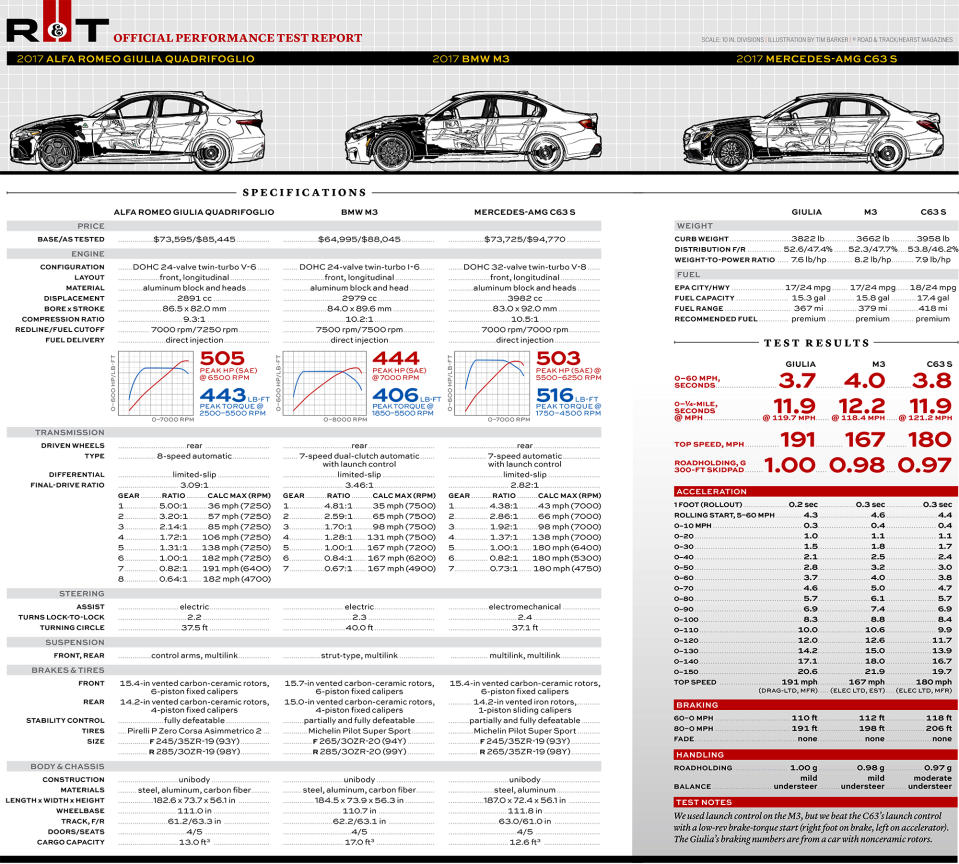
You Might Also Like

 Yahoo Autos
Yahoo Autos 